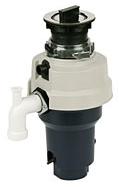Sink waste disposal units
 Sink waste disposal units are usually fitted directly under the kitchen sink and grinds soft waste (such as vegetable peelings, tea bags, fruit skins, fruit stones, nutshells, corncobs, crust etc.) to a pulp before it gets into the drain.
Sink waste disposal units are usually fitted directly under the kitchen sink and grinds soft waste (such as vegetable peelings, tea bags, fruit skins, fruit stones, nutshells, corncobs, crust etc.) to a pulp before it gets into the drain.
he pulp is then washed down the drain without causing a blockage.
Fitting to sink
Most waste disposal units fit to an 89mm (3½ inch) sink outlet rather than the standard 38mm (1½ inch) outlet.
Some sinks will have the large hole; double sinks will often have the standard outlet in one bowl and the larger outlet in the other - which makes good sense as you end up with a 'conventional' sink as well as one fitted with a waste disposal unit.
When the sink only has a standard 38mm (1½ inch) outlet, you may be able to find a waste disposal unit with a smaller inlet (although these are not so common and tend not to work as well) or be able to enlarge the hole in the bottom of the sink.
Generally it is only possible to enlarge the hole on aluminium sinks - a suitable cutter may be available from a local hire shop.
Most disposal units do not have an arrangement for dealing with an overflow outlet from the sink; if necessary the overflow should be fed into the trap after the disposal unit.
Waste disposal units vary in height depending on the model; often they will not fit between the bottom of the sink and the shelf in the cupboard - so the shelf will either have to be cut to form an aperture or removed completely.
Waste connection
Most waste disposal units connect to a 38mm (approx 1½") waste trap and pipework - generally Bottle or Grease traps must NOT be used. Depending on the model purchased, and the type of waste trap already fitted, it may be possible to connect to the existing waste pipe with only minor changes.
Try to arrange the waste pipes to achieve a fall of 15 degrees (26cm per metre), this will help flush the waste material along the pipework.
Where the waste pipe discharges into a gully, the outlet must be below the grating - if necessary, the grating must be cut away and an extension fitted to the bottom of the waste pipe to take it below the grating.
Electrical connection
The electrical supply for a waste disposal unit generally need to be 220/240volt (UK), the current required depends upon the model and the supply should be fused according to the installation instructions provided. The electrical supply should be made in accordance with Part P of the building regulations.
Operation is controlled either by a manual switch, a wireless remote control or automatically depending on the model/wiring. Wireless remote control switches can be purchased separately.
Installing a waste disposal unit.
If installing onto an existing sink:
- Clear out the cupboard under the sink.
- Remove the existing waste trap from both the sink and the waste pipe - catch any water from the trap in a bowl or similar.
- Remove the existing outlet from the sink - the actual method depends on the arrangement, it may be a large nut under the sink or a screw in the middle of the outlet from above - see examples of the different methods used.
- Clean off any old sealing compound from inside and under the sink.
Offer up the waste disposal unit under the sink and :
- If there is insufficient depth under the bottom of the sink, either mark and cut away a section of the shelf or remove the shelf completely.
- Check for clearance around the sink outlet on the underside and if necessary mark and cut away some of the sound deadening material fixed on the underside.
The method of fixing a waste disposal unit to a sink does vary with different makes and models, however they generally consist of:
- A special fitting to the sink outlet.
and - The body of the waste disposal unit which attaches to the sink fitting.
So,
- Fit the special sink outlet using any appropriate gaskets supplied.
- Fit the waste disposal unit to the sink outlet, you can usually rotate the unit to line up the outlet with the waste trap/pipe.
With the waste unit suitable aligned, adjust or make up the waste pipe as necessary so that the waste trap (a 'P' or an 'S' trap - NOT a bottle trap) will fit between the waste disposal unit and the waste pipe - make sure that there is a good fall in the waste pipe to help the flow of the ground up waste.
Connect the waste disposal unit to a suitable electrical supply and, if necessary, a suitable switch above and away from the sink.
